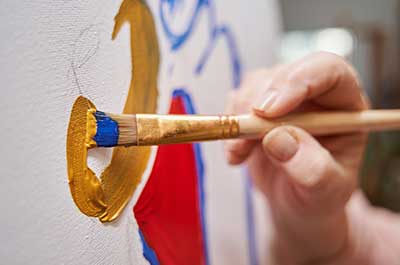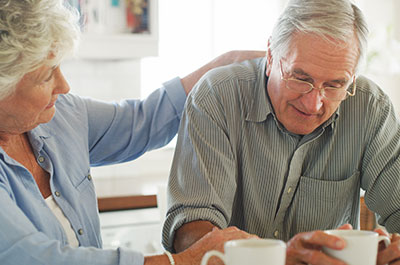When a loved one has been diagnosed with cancer, it’s natural to want to lend your support. But what will really help them as they begin cancer treatment?
Creating a cancer care package is one way to show you care, says Cynthia Ulreich, an oncology nurse practitioner at Henry Ford Cancer. "Fill it with items that will make your friend or family member feel more comfortable in the hospital and help them pass the time during treatment," she says. “I often hear patients say they want to maintain a sense of normalcy during cancer treatment. Creating a package that includes their favorite games or books, snacks or a warm blanket is a great option.”
The Elements Of A Cancer Care Package
Tailor your cancer care package to the person who is receiving it. Before you start gathering items, talk to your loved one (or to their spouse, partner, family member, etc.) who can advise you.
Ask how they're feeling to get a sense if they're even ready to receive a care package. Learn more about their general treatment plan to help you know what kind of items they might need. Those who undergo chemotherapy may need activities to keep them busy during longer treatment sessions, as opposed to those who are having radiation treatment, for example.
To get started, Ulreich recommends filling your cancer care package with some of these items:

Henry Ford Cancer
- Chapstick. Lips can become dry during radiation and chemotherapy. But Ulreich stresses to avoid items with petroleum jelly, as it can trap bacteria next to the skin and cause an infection. (And cancer treatment can weaken someone's immune system, making it more difficult to fight off infection.)
- Coloring books and travel games. Chemotherapy can take hours over the course of weeks or months. Coloring books (especially those created for adults) and travel size games offer a fun distraction.
- Framed photos. Include something that's sentimental, like a framed photo of family or friends. It offers a sense of home, and a sense of self, while in the hospital.
- Fuzzy socks or slippers. “A lot of patients experience neuropathy (or nerve damage) in their feet, which is a side effect of chemotherapy," says Ulreich. Slippers or warm, fuzzy socks with rubber bottoms can keep feet warm and protected."
- Hand sanitizer. Since cancer treatment can weaken someone's immune system, it's important to keep hands clean to prevent the spread of germs. Include travel size hand sanitizers so they're easy to bring on the go.
- Hard candy or gum. Radiation and chemotherapy can affect someone's taste buds and can often cause a dry or metallic taste. Hard candy and gum minimize those effects.
- Hat or salon gift certificate. Hair loss is a common side effect of cancer treatment. Ulreich suggests including a hat or even a gift card to a salon that specializes in styling hair or wigs for those who have cancer.
- Hobbies. Does your loved one knit? Include yarn and patterns. For the card player, a new deck of cards; for the painter, a set of brushes; and for the reader, books.
- Journal and colored pens. It’s great to have a place to keep notes about appointments and how they’re feeling. And don’t forget to include fun, colorful pens. Ulreich says people often use different color pens to track how they’re feeling or to differentiate between various medical appointments.
- Lap blanket or zipper hoodie. Cancer treatment can lower your red blood cell count, making you feel cold. Lap blankets offer comfort and warmth. Instead of a sweatshirt, include a zip-front hoodie for easy access to medication ports.
- Lotion sans perfume. Radiation and chemotherapy can cause dry skin. But skip lotions with added scents, as they may cause skin irritation or nausea.
- Neck pillow or heating pad. Chemotherapy often causes joint aches in the knees, ankles and hips. Heating pads can alleviate some of that discomfort.
- Pedometer. “We encourage our patients to walk during treatment to maintain bone strength and keep energy levels high,” says Ulreich. Plus, walking releases endorphins to relieve pain and stress, so a pedometer is a great way to encourage them to keep moving.
- Pre-packaged nutrition shakes. For those experiencing nausea, pre-packaged nutrition shakes like Ensure, Boost or Carnation Instant Breakfast are often a good meal option.
- Stress ball. A stress ball is a great way to strengthen someone's hands and to help get an IV started in the arm. Squeezing the stress ball makes veins in the arm more visible.
- Sunscreen. Chemotherapy can make skin more sensitive to the sun. Include sunscreen with SPF 30 or higher.
Other Ways You Can Help
What else can you do to offer help and show support? Ulreich says it’s simple: Be there for them. If they're experiencing nausea, offer to set up a meal delivery among friends. The smell of cooking can intensify nausea, so preparing a meal and bringing it to them can be helpful. An added bonus: food delivery also brings regular company.
You can also simply set up regular phone calls and lunch dates, drive them to appointments, pick up medication from the pharmacy - and just be there as a source of encouragement. “We like to tell people they are living with cancer, not dying from it,” says Ulreich. “Encourage your loved one to live their life.”
Reviewed by Cynthia Ulreich, an advanced oncology certified nurse practitioner who works at Henry Ford Cancer - Detroit.



